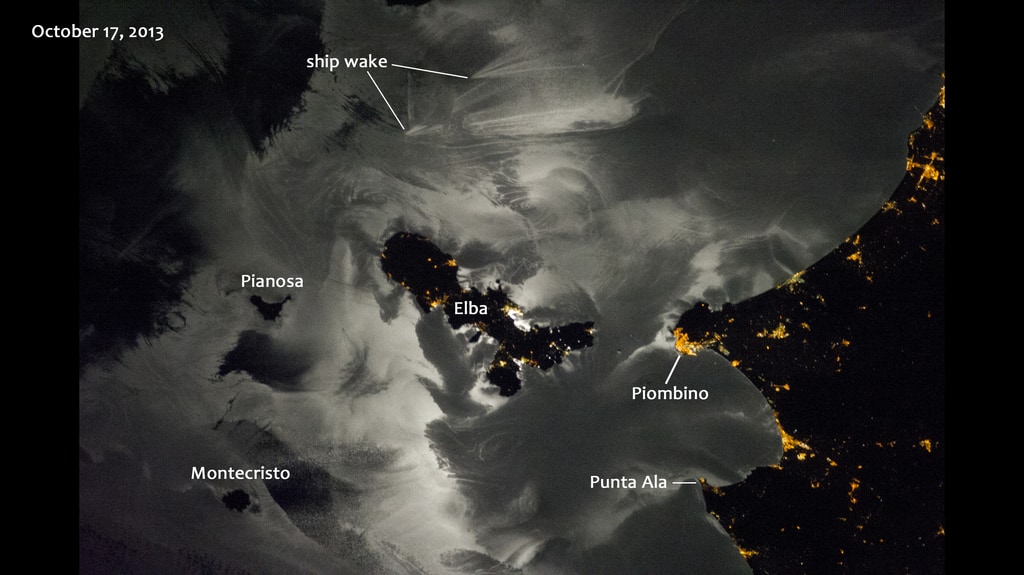Earth
ID: 31108

A crew member onboard the ISS took this photograph of the northern Mediterranean Sea and some coastal Italian towns and islands on October 17, 2013. The reflection of the Moon on the sea surface—moonglint—reveals highly complex patterns. The strongest reflection is near the center of the Moon’s disc, which brightens the water around the island of Elba. In these complex patterns, the dark areas of the sea surface can some- times make islands, such as Montecristo and Pianosa, harder to see.
The reflection off sea surfaces captures many different natural processes but also some made by humans. North of Elba, waves trailing behind ships make a classic V-shaped pattern. The meandering line coming off Montecristo Island is an island wake, a result of alternating vortices of wind that develop on the downwind side of the island. This wake is the strongest evidence that a northeast wind was blowing (right to left in this image) on the night of the photo. A shorter, meandering wind pattern is being shed off Punta Ala on the mainland. Smoother surfaces, protected from wind, are usually brighter because they are a better mirror for moonlight.
The sea surface also displays numerous tight swirls known as gyres. The broad swath of parallel lines (top left) is probably part of the larger circulation of the sea, which usually experiences north-flowing currents around Elba.
Moonglint Near Elba and the Mediterranean

The reflection off sea surfaces captures many different natural processes but also some made by humans. North of Elba, waves trailing behind ships make a classic V-shaped pattern. The meandering line coming off Montecristo Island is an island wake, a result of alternating vortices of wind that develop on the downwind side of the island. This wake is the strongest evidence that a northeast wind was blowing (right to left in this image) on the night of the photo. A shorter, meandering wind pattern is being shed off Punta Ala on the mainland. Smoother surfaces, protected from wind, are usually brighter because they are a better mirror for moonlight.
The sea surface also displays numerous tight swirls known as gyres. The broad swath of parallel lines (top left) is probably part of the larger circulation of the sea, which usually experiences north-flowing currents around Elba.
For More Information
Credits
Amy Moran (Global Science and Technology, Inc.): Lead Technical Support
Please give credit for this item to:
NASA, Earth at Night book
NASA, Earth at Night book
Short URL to share this page:
https://svs.gsfc.nasa.gov/31108
Keywords:
SVS >> Mediterranean
SVS >> Night lights
SVS >> Hyperwall
SVS >> Astronaut
SVS >> ISS
NASA Science >> Earth
https://svs.gsfc.nasa.gov/31108
Keywords:
SVS >> Mediterranean
SVS >> Night lights
SVS >> Hyperwall
SVS >> Astronaut
SVS >> ISS
NASA Science >> Earth











